Meta Quest Pro review: A next-gen headset for the VR faithful<p>Currently, few things make people's eyes roll harder than the metaverse. As someone who grew up reading sci-fi novels and dreaming about what virtual worlds might look like in the future, that's kind of sad, but I get it. Mark Zuckerberg is so thirsty to make those dreams a reality that he’s betting billions of dollars and the survival of his company on the metaverse being The Next Big Thing. Meanwhile, the average person is still wondering what the point of having a VR headset really is, aside from maybe smashing some polygons in
Superhot or
Beat Saber.</p><p>However, even though it feels like VR headsets have been around forever, we're still very much in the early days of virtual reality. It was only a couple of years ago when the company previously known as Facebook brought VR to the masses with the
Quest 2. And now with the <a href="
https://shopping.yahoo.com/rdlw?merchantId=66ea567a-c987-4c2e-a2ff-02904efde6ea&siteId=us-engadget&pageId=1p-autolink&featureId=text-link&merchantName=Amazon&custData=eyJzb3VyY2VOYW1lIjoiV2ViLURlc2t0b3AtVmVyaXpvbiIsInN0b3JlSWQiOiI2NmVhNTY3YS1jOTg3LTRjMmUtYTJmZi0wMjkwNGVmZGU2ZWEiLCJsYW5kaW5nVXJsIjoiaHR0cHM6Ly93d3cuYW1hem9uLmNvbS9NZXRhLVF1ZXN0LVByby1PY3VsdXMvZHAvQjA5WjdLR1RWVy8_dGFnPWdkZ3QwYy1wLW8tMjUtMjAiLCJjb250ZW50VXVpZCI6ImRmNTkwYTFmLWE5NDQtNDM5Mi1iMWUxLWZlOGE4MDc4MzY1NiJ9&signature=AQAAAcCuQXNiICmV7SZulRcGGHV_cvTTo6CCjEXaPygt3Ueu&gcReferrer=https%3A%2F%2Fwww.amazon.com%2FMeta-Quest-Pro-Oculus%2Fdp%2FB09Z7KGTVW%2F" class="rapid-with-clickid" data-i13n="elm:affiliate_link;sellerN:Amazon;elmt:">Quest Pro[/url], Meta is trying to foster a new baseline level of tech designed to make digital worlds feel more lifelike, intuitive and immersive. And honestly, I think Meta has done it, because while its $1,500 price is hard to justify, it’s easy to see the potential of what this hardware can support.</p><span id="end-legacy-contents"></span><h2>Hardware and optics</h2><div id="916dbf67f28b49f1b8351291c5624a5a"><iframe src="
https://www.youtube.com/embed/cpcWxXjgIi0?rel=0" style="top:0;left:0;width:100%;height:100%;position:absolute;border:0;" allowfullscreen scrolling="no"></iframe></div><p>Packing a Qualcomm Snapdragon XR2+ chip, 12GB of RAM and 256GB of storage, the Quest Pro delivers 50 percent more performance than the Quest 2, according to Meta. However, the real challenge in designing this headset was blending its standalone design with something that's simple and comfortable to wear, and I think Meta has struck an almost ideal balance.</p><p>By switching to new pancake lenses, the company was able to reduce the thickness of the headset while still delivering a relatively high resolution of 1,800 x 1,920 pixels per eye. For comparison, that's higher than what you get from the Valve Index (1,440 x 1,600 per eye) but a bit less than the Vive Pro 2 (2,448 × 2,448 per eye). Though topping out with a 90Hz refresh rate, the Quest Pro’s visuals aren’t quite as fast as most of its high-end PC-based rivals. For me, that hasn't been a huge deal, as graphics and gameplay have been smooth and stutter-free. But I should mention I've never really had problems with VR-related motion sickness, so your experience may vary.</p><figure>
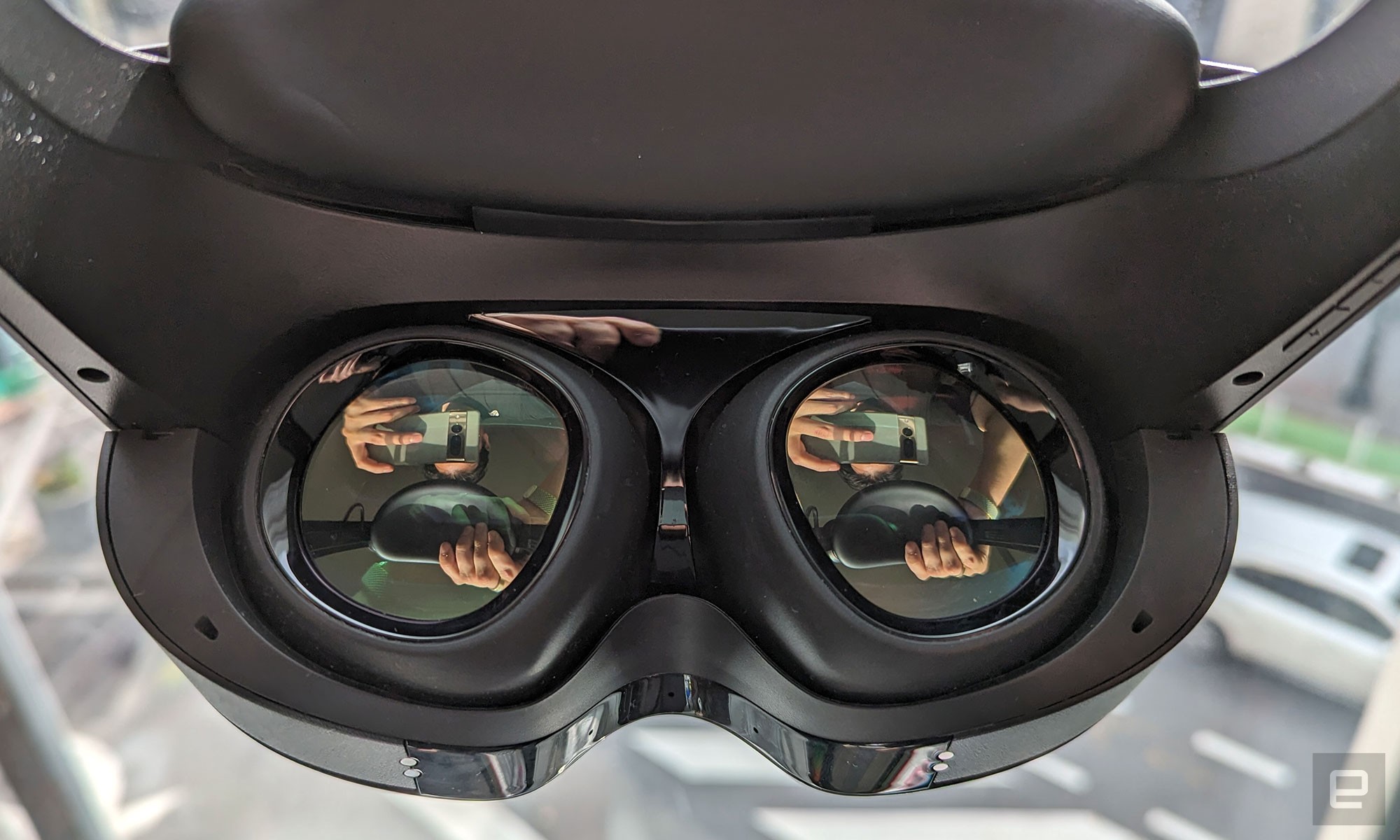
<figcaption></figcaption><div class="photo-credit">Sam Rutherford/Engadget</div></figure><p>My one nitpick is that I wish the Quest Pro's 96-degree vertical field of view was a little bit taller. I've found that due to the headset's visor-like design and its FOV, you tend to always have a bit of the real world peeking in across the bottom of your eye line. Thankfully, its 106-degree horizontal FOV is pretty much as good or better than all of its rivals except for the Vive Pro 2's 116 degrees.</p><p>Elsewhere, the Quest Pro features 10 sensors on the interior and exterior of the device. The five outward-facing cameras support full-color passthrough, hand-tracking and stuff like scene understanding without the need for additional external sensors. Meanwhile, the five inward-facing sensors track eyes and face movements for features like foveated rendering and enhanced avatar animations, but more on that later.</p><h2>Design and fit</h2><figure>
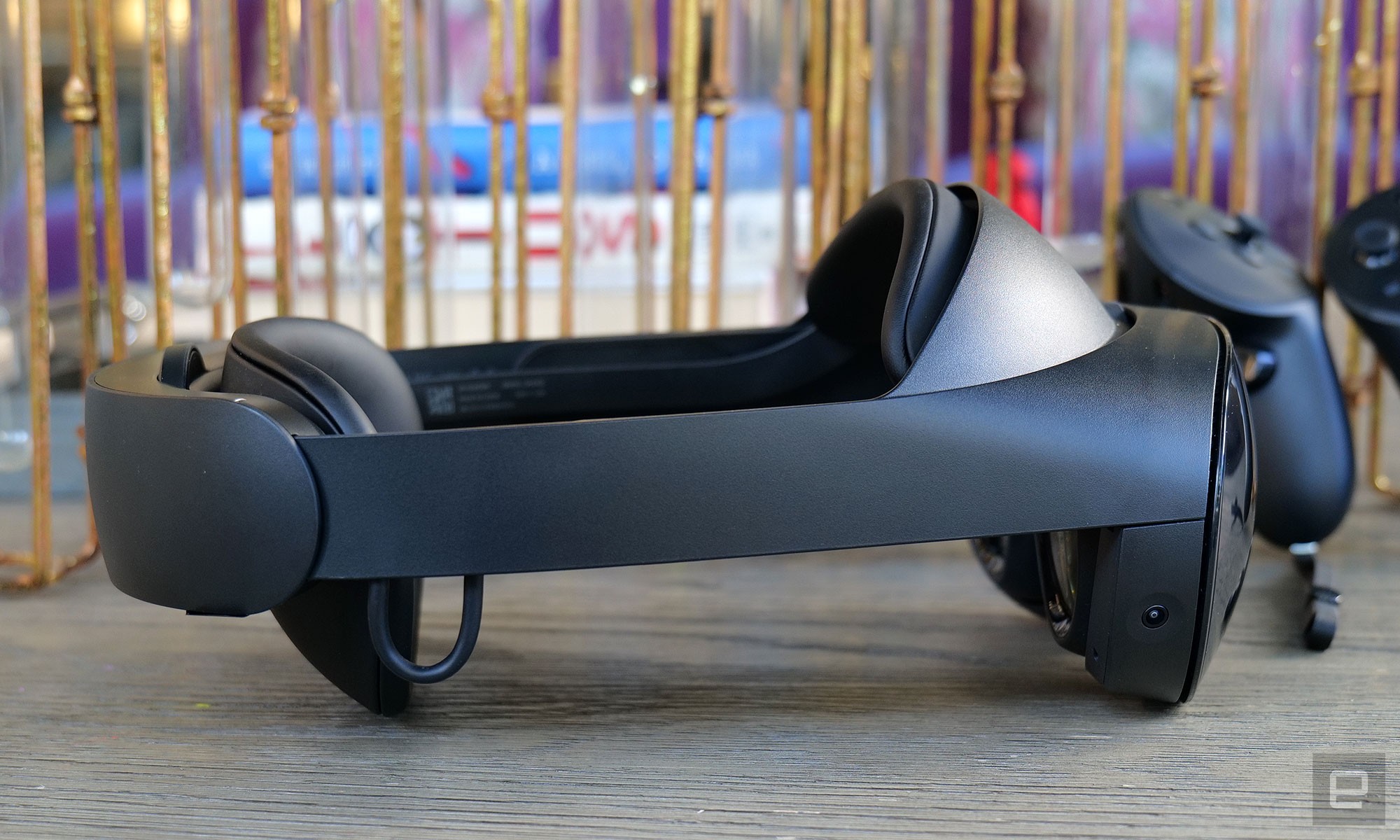
<figcaption></figcaption><div class="photo-credit">Sam Rutherford/Engadget</div></figure><p>To balance the trade-off between power and fit, Meta cleverly used a curved battery built into the back of the headset, so there's no need for wires or a belt-mounted power cell. And when combined with a soft forehead cushion and a handy dial for adjusting the headband, you get a headset that's extremely easy to put on and wear. Further adjustments are provided via a small dial in front that changes lens distance, while IPD (interpupillary distance) adjustment is handled by simply moving each eyepiece left and right as needed. All told, it's an incredibly straightforward setup, and thanks to the Quest Pro's fit calibration feature, the headset can remind you to adjust your settings if it notices things aren't quite right. And when it comes to sound, you get speakers that support spatial audio built into the arms of the headset, though if you prefer to use your own headphones, there’s a 3.5mm jack too.</p><figure>
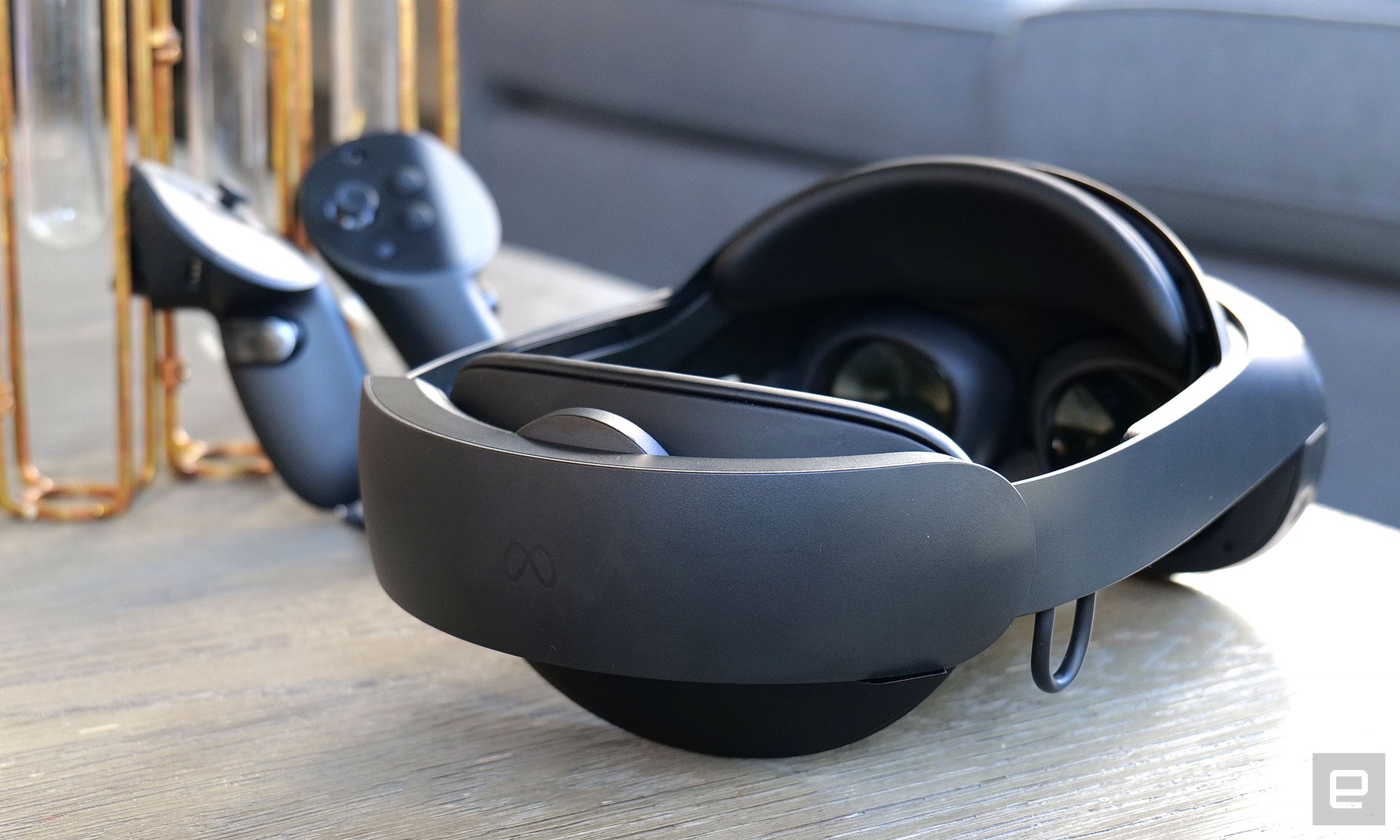
<figcaption></figcaption><div class="photo-credit">Sam Rutherford/Engadget</div></figure><p>That said, even with all the attention Meta paid toward creating a comfortable and balanced headset, the Quest Pro's heft can still be a bit of an issue. If you're hopping in and out of VR, you might not notice much. But with a weight of just over a pound and a half, in longer sessions, I noticed my forehead sometimes got a bit sore. Usually fiddling around with how the Quest Pro sat on my head was enough to relieve excess pressure. But I also wouldn't be surprised if this setup gave some people a low-grade headache during extended use. And I'd also be remiss not to mention the sweat factor, as the leather forehead pad can get damp depending on your activity, and sometimes I wonder if having active cooling on a VR headset is what we need. Heck, developers could even use fans to mimic a breeze in a game or movie, which could be kind of nice.</p><h2>Controllers</h2><p>The other big part of the headset's kit is the new Touch Pro Controllers. Meta is using the same basic design as what we got on the
Quest 2. The big difference this time is that instead of relying on a big light ring with LEDs, the controllers now have their own built-in sensors for both hand and finger tracking. Not only does this help streamline their design, but I also found a noticeable upgrade in accuracy and responsiveness.</p><figure>
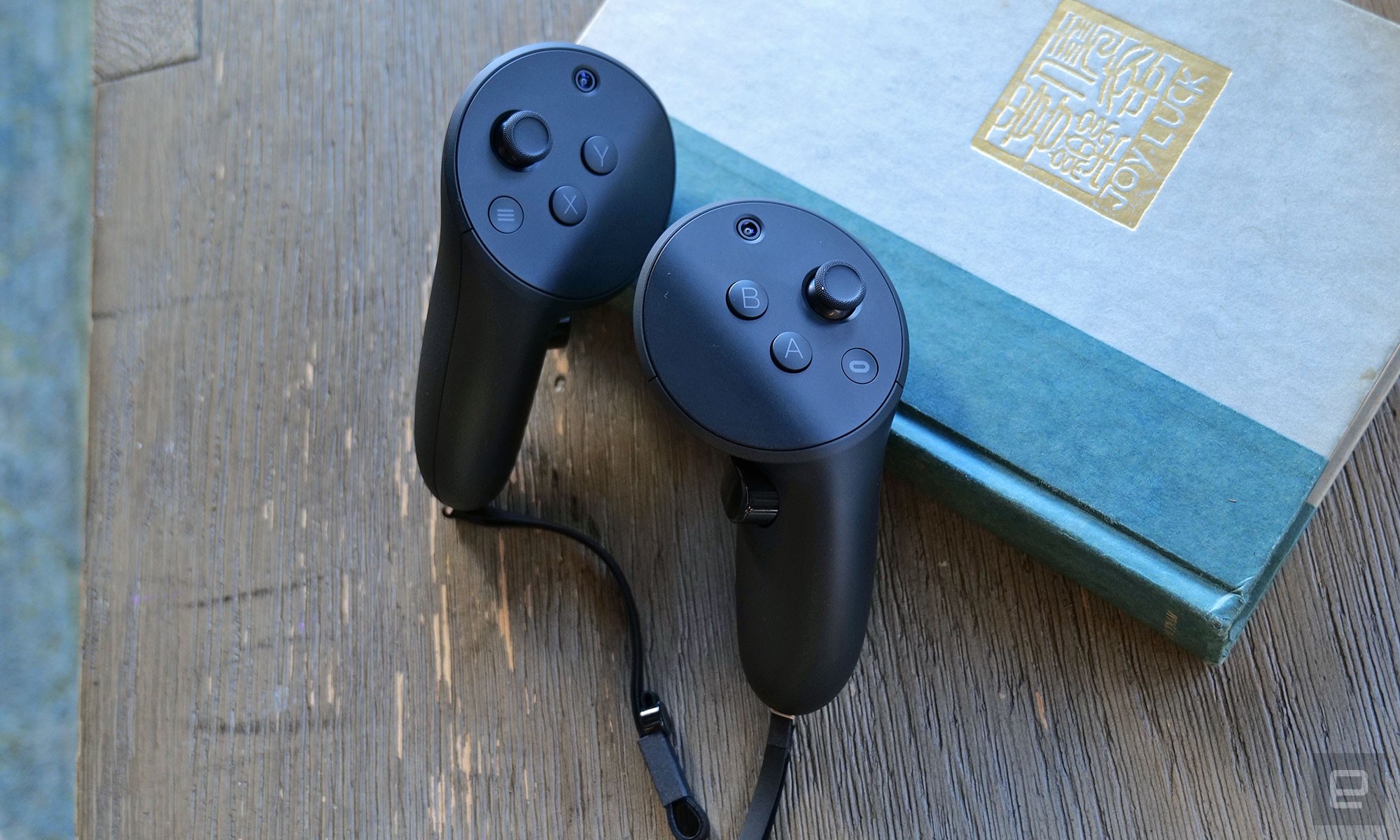
<figcaption></figcaption><div class="photo-credit">Sam Rutherford/Engadget</div></figure><p>The controllers also have much-improved haptics that adds an extra level of immersion, especially in apps where you can flip the controllers over to use as a stylus. For example in Painting VR, brushes use a variety of rumbles and vibrations to convey a sense of size and weight. The overall effect feels much like HD Rumble on the Nintendo Switch's Joy-Con, but with even better fidelity for force feedback.</p><p>I also appreciate the controller’s subtly textured rubberized grips that make things feel secure even in the heat of virtual battle. However, I kind of miss the hand straps Valve uses on the Index controllers which allow you to quickly switch between buttons and finger or hand gestures without needing to set the controllers down.</p><h2>General performance and apps</h2><p>Of course the real magic happens when hardware meets software, and at least out of the gate, the Quest Pro offers some pretty impressive performance. The headset’s optics are sharp while eliminating nearly any hint of the screen door effect. Text is also very legible and I had no trouble writing part of this review in VR. Next, when my colleague Cherlynn Low visited my virtual office in Horizon Workrooms, I think the combination of Quest Pro’s eye and facial tracking to deliver more lifelike expressions on my avatar might have been convincing enough to get her to spend more time in VR. And on my end, support for spatial audio makes working in VR feel less like floating in a simulation and more like actually working in an office with someone else.So even though Cherlynn was sick that day, we were able to collaborate without me risking catching what she had, and it felt kind of heartwarming in a weird, nerdy way.</p><figure>
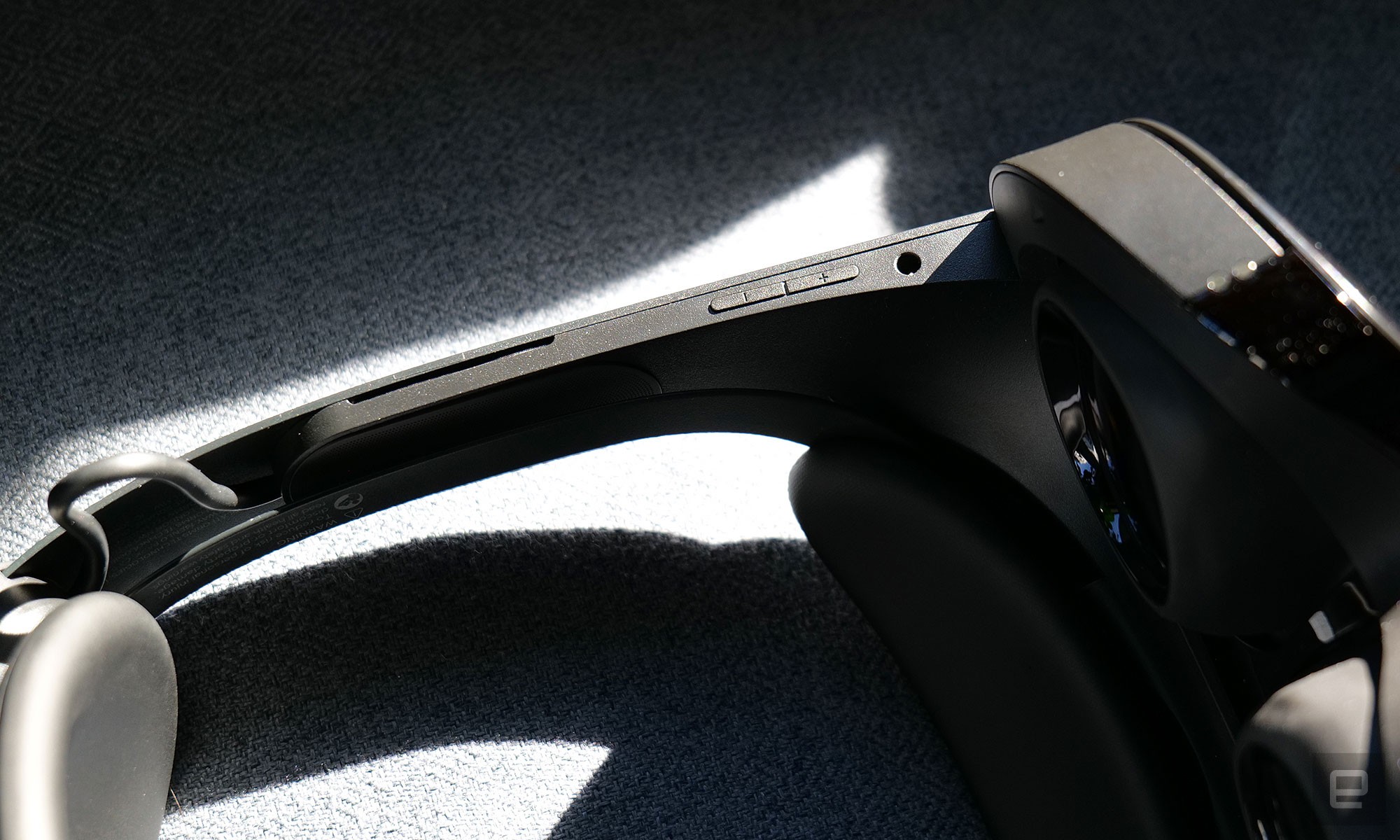
<figcaption></figcaption><div class="photo-credit">Sam Rutherford/Engadget</div></figure><p>On top of that, a lot of tent-pole features like Meta's scene understanding just kind of work, at least most of the time. I found that the Quest Pro was pretty good at automatically detecting the position of floors and walls, so I didn't have to constantly redraw the boundaries for my room-scale guardian. It even automatically detected some objects like my desk (and remembered them in subsequent sessions), which makes it easier to set up a virtual workspace that mimics what I have IRL. Though I did notice in rooms that were more cluttered, things didn't always work quite as smoothly.</p><p>The Quest Pro's full-color passthrough is also really impressive. Don’t get me wrong, it’s still not as good as using your eyes to navigate meatspace. But it's more than accurate enough to let me walk from room to room to grab a glass of water without taking off the Quest Pro or bumping into anything.</p><p>In apps like
Cubism, I had a blast positioning blocks to solve puzzles in three dimensions and in
I Expect you to Die I got to live out my childhood fantasy of being a secret agent. And in Tribe XR, I was able to enjoy the basics of mixing and beat-matching while using the same equipment pro DJs use, at least virtually. The improved three-window multitasking in the Quest Pro’s desktop mode even makes it easier to switch between apps and stay connected while you're in VR. Or, well, it would be if there was a wider availability of 2D apps.</p><figure>
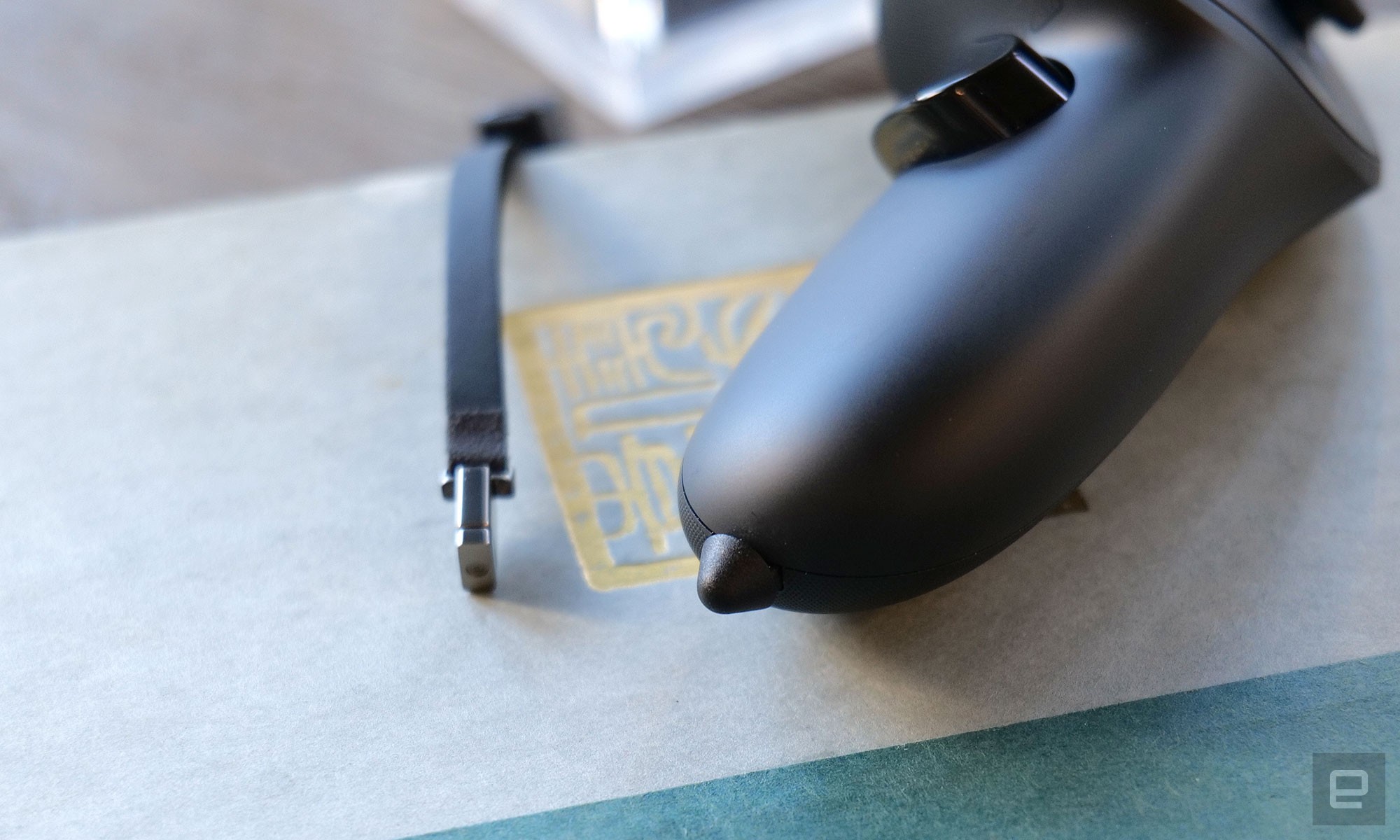
<figcaption></figcaption><div class="photo-credit">Sam Rutherford/Engadget</div></figure><p>And that kind of brings me to the big issue with the Quest Pro: there just aren't a lot of optimized apps that really take advantage of its upgraded capabilities. For traditional 2D apps, while important stuff like Slack is supposedly on the way, there isn't even support for messaging software like WhatsApp. So if you're like me and aren't a frequent user of Instagram or Facebook Messenger, things can still feel a bit disconnected.</p><p>But perhaps the more telling thing is currently how few apps there are in the Quest Pro section of the store. Titles like Nanome, which lets you view molecules in VR are really neat and interesting, but rather niche. I don't know about you, but I don’t really spend a ton of time staring at various compounds and conformations in my free time – and I was a bio major in college.</p><figure>
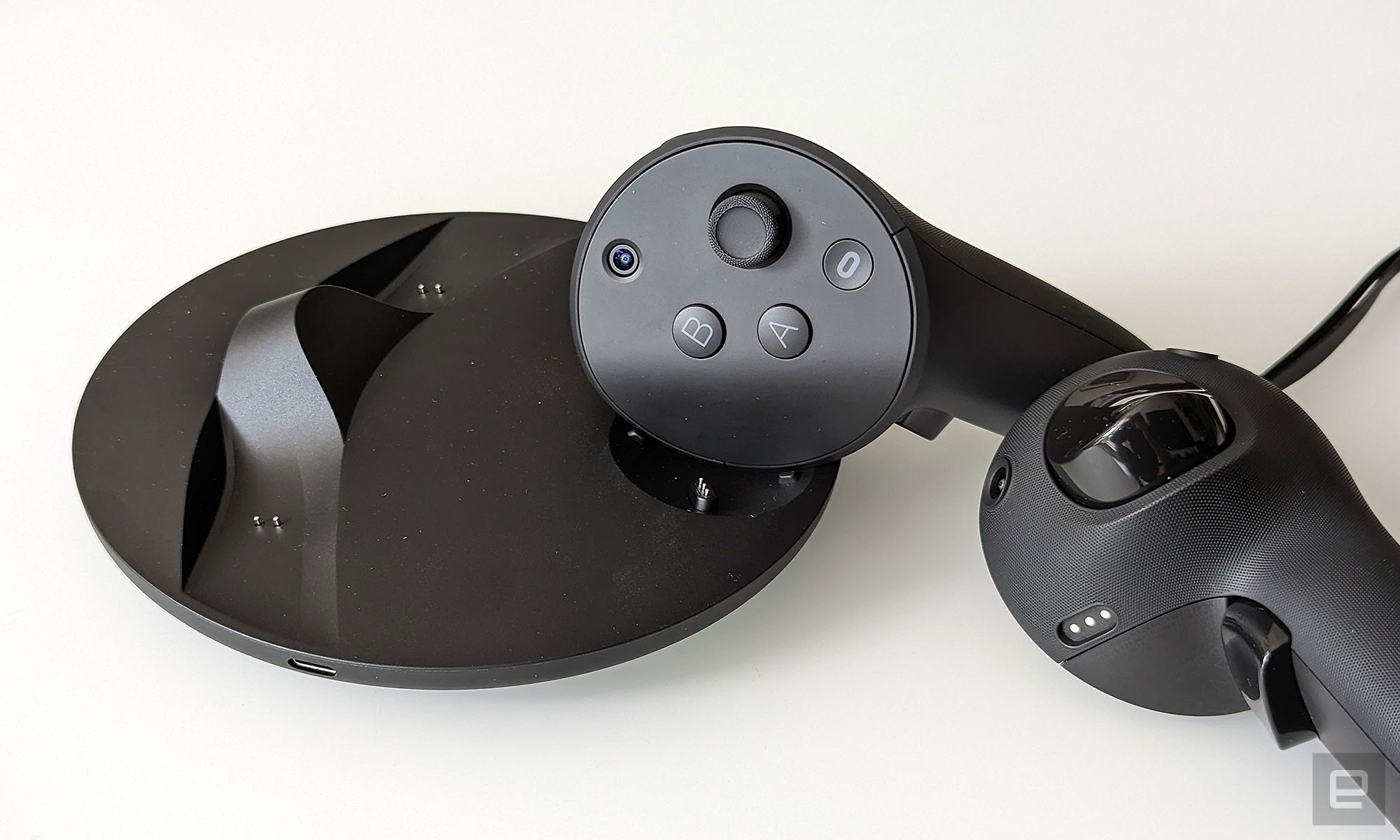
<figcaption></figcaption><div class="photo-credit">Sam Rutherford/Engadget</div></figure><p>This is sort of to be expected, as it's going to take a while for developers to take advantage of the Quest Pro's new features. This headset kind of feels like the Nintendo Switch at launch but without a tentpole game or app like
Breath of the Wild to pair with it. Sure, you can go back and enjoy all the old Quest apps, as the Pro is fully backward compatible with existing software. But when you're spending $1,500 on a VR headset, you kind of want something you can lose yourself in for the next month or more.</p><p>My other gripe is that, while a lot of the big-ticket features work surprisingly well, a lot of the finer details seem half-baked. For example, it took almost an hour for Cherlynn to successfully visit my office in Horizon Workrooms. Because this is VR, you can't just send a link to a meeting like you would in Zoom, which meant she had to bounce back and forth between her headset, phone and laptop just to find where to accept my invite. And when I wanted to upload an image to pin on my virtual whiteboard, first I had to go back to my fake chair at my fake desk just to upload something, before needing to move back to the whiteboard again to post it. That's just convoluted, and that’s even with my having already set up Meta’s Remote Desktop app. And while Meta says it's working on it, there are other little frustrations like being limited to a single virtual desktop (which you can’t even move by the way, at least not right now) when connected to a Windows PC while Mac users get three.</p><h2>Charging and accessories</h2><p>While Meta doesn't provide official battery life claims for the Quest Pro, I've found that you're looking at between two and a half and three and a half hours on a charge, depending on the use case. This is typically longer than I want to be in VR in a single sitting, but if you need to be jacked in for extended periods, the Quest Pro also comes with a six-foot USB-C cable you can use to keep it running.</p><figure>
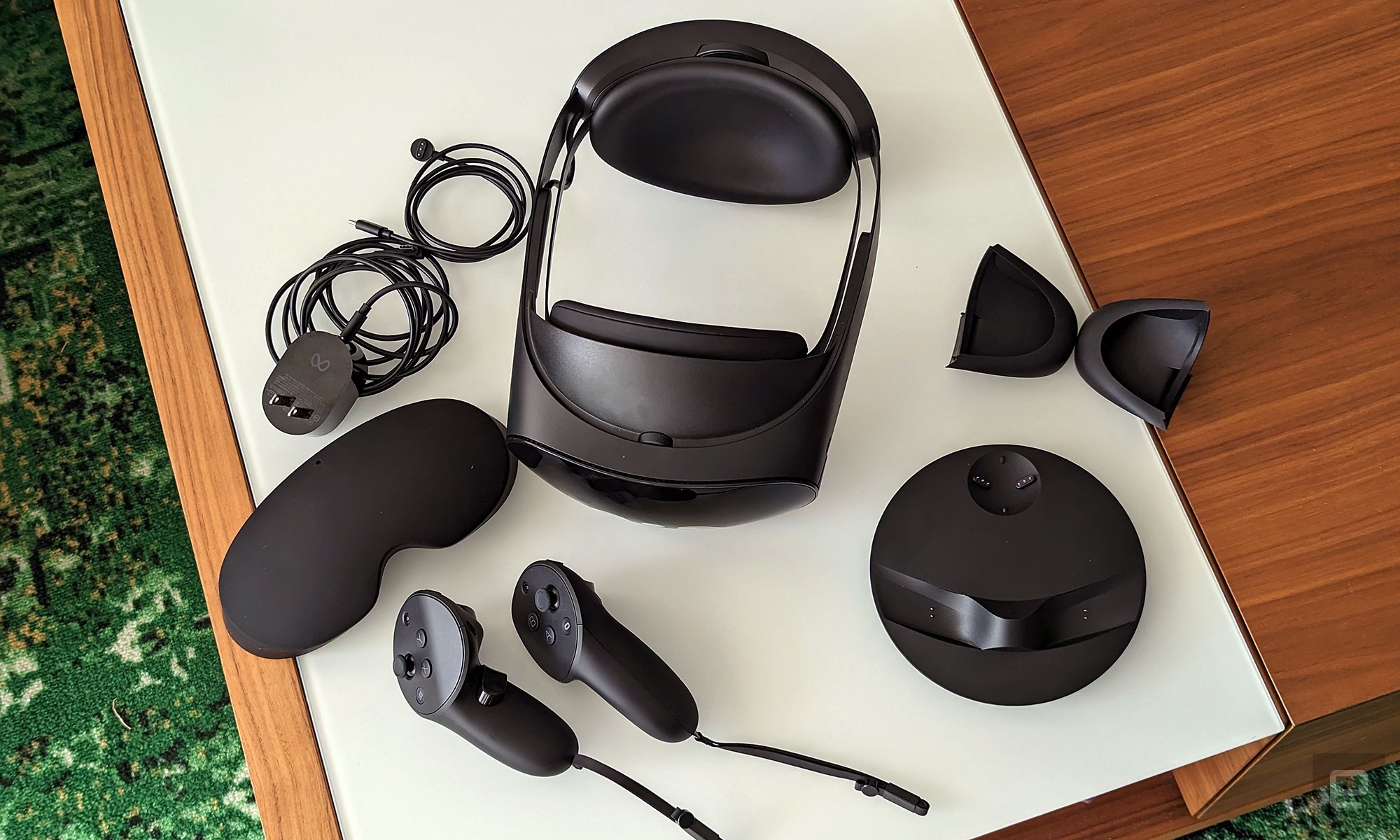
<figcaption></figcaption><div class="photo-credit">Sam Rutherford/Engadget</div></figure><p>Other bundled accessories include a protective silicone cover and two light blockers that attach magnetically to the side of the headset, which helps cut down on potential distractions from the physical realm. But if you really want that complete VR-dive experience, you'll have to shell out $50 for Meta's Full Light Blocker. Or you opt for the low-tech solution and just move to a dark room. You also get two Quest Touch Pro controllers along with two wrist straps and stylus nibs that can be attached to the bottom of the gamepads to suit your needs.</p><p>When it comes to keeping everything juiced up, there's a really handy wireless charging dock that holds both the headset and the controllers. Admittedly, getting the controllers to sit properly in the dock is a bit tricky at first. But the secret is holding them as if you're using them, before twisting your wrists inwards and then dropping them on the dock. If you did it right, you'll feel a little rumble and see the tiny indicator lights fire up. There's also a dedicated cable for charging the controllers, but you only get one. So if you're traveling with the Quest Pro and you leave the dock at home, you'll need to charge the controllers one at a time.</p><h2>Wrap-up</h2><p>Look, trying to review a next-gen VR headset feels kind of like evaluating a Mars colony based on the spaceship that takes you there: Ultimately the <a href="
https://shopping.yahoo.com/rdlw?merchantId=66ea567a-c987-4c2e-a2ff-02904efde6ea&siteId=us-engadget&pageId=1p-autolink&featureId=text-link&merchantName=Amazon&custData=eyJzb3VyY2VOYW1lIjoiV2ViLURlc2t0b3AtVmVyaXpvbiIsInN0b3JlSWQiOiI2NmVhNTY3YS1jOTg3LTRjMmUtYTJmZi0wMjkwNGVmZGU2ZWEiLCJsYW5kaW5nVXJsIjoiaHR0cHM6Ly93d3cuYW1hem9uLmNvbS9NZXRhLVF1ZXN0LVByby1PY3VsdXMvZHAvQjA5WjdLR1RWVy8_dGFnPWdkZ3QwYy1wLW8tMjUtMjAiLCJjb250ZW50VXVpZCI6ImRmNTkwYTFmLWE5NDQtNDM5Mi1iMWUxLWZlOGE4MDc4MzY1NiJ9&signature=AQAAAcCuQXNiICmV7SZulRcGGHV_cvTTo6CCjEXaPygt3Ueu&gcReferrer=https%3A%2F%2Fwww.amazon.com%2FMeta-Quest-Pro-Oculus%2Fdp%2FB09Z7KGTVW%2F" class="rapid-with-clickid" data-i13n="elm:affiliate_link;sellerN:Amazon;elmt:">Quest Pro[/url] is a vessel to experience fancy new software that doesn’t exist yet. And right now, there just aren't enough apps to really say if that colony is a utopia or
Autobot city after Megatron attacks – burned down and wasted.</p><figure>
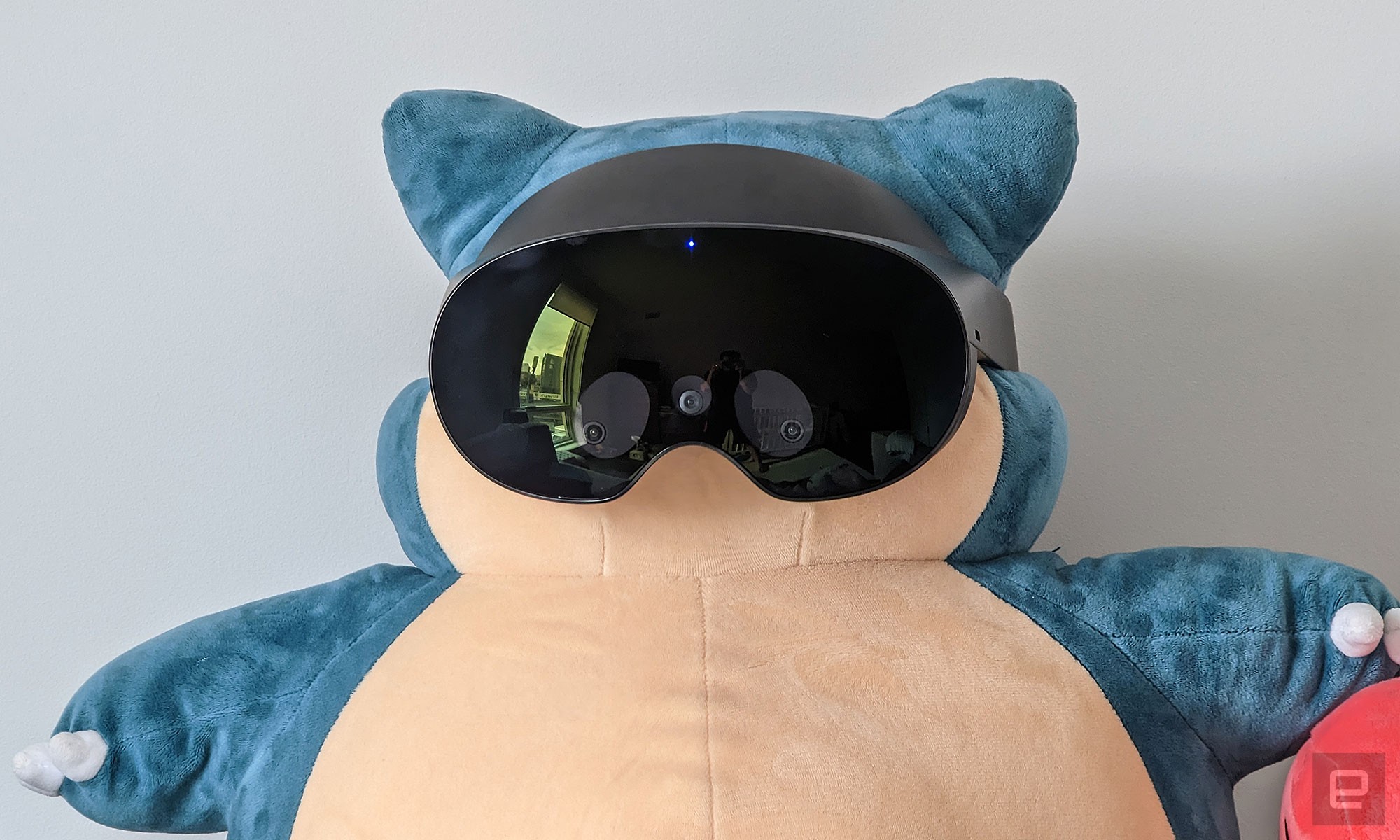
<figcaption></figcaption><div class="photo-credit">Sam Rutherford/Engadget</div></figure><p>But if we can ignore that issue for a minute, at least on a hardware level, there's a lot to like about the Quest Pro. It offers similar or, in some situations, better performance than other high-end consumer headsets — all without the need for wires or a beefy PC. You can switch between controllers and hand gestures at a whim, while the plethora of sensors makes the headset a really great standalone device. You get sharp visuals, a streamlined design and surprisingly good battery life — not to mention a really handy charging dock.</p><p>But for now, we're going to have to wait for the headset’s software and experiences to catch up, which is a lot to ask when it costs this much to strap on the goggles. Purchasing a Quest Pro, at least for now, is something you do on faith, because you believe in the promise of VR and where it might go in the not-too-distant future. So while the Quest 2 can handle basic VR, the Quest Pro adds power and finesse in a way that could unlock how people explore virtual worlds. The tech is there but are you willing to fork over big money to try it?</p>
Source:
Meta Quest Pro review: A next-gen headset for the VR faithful